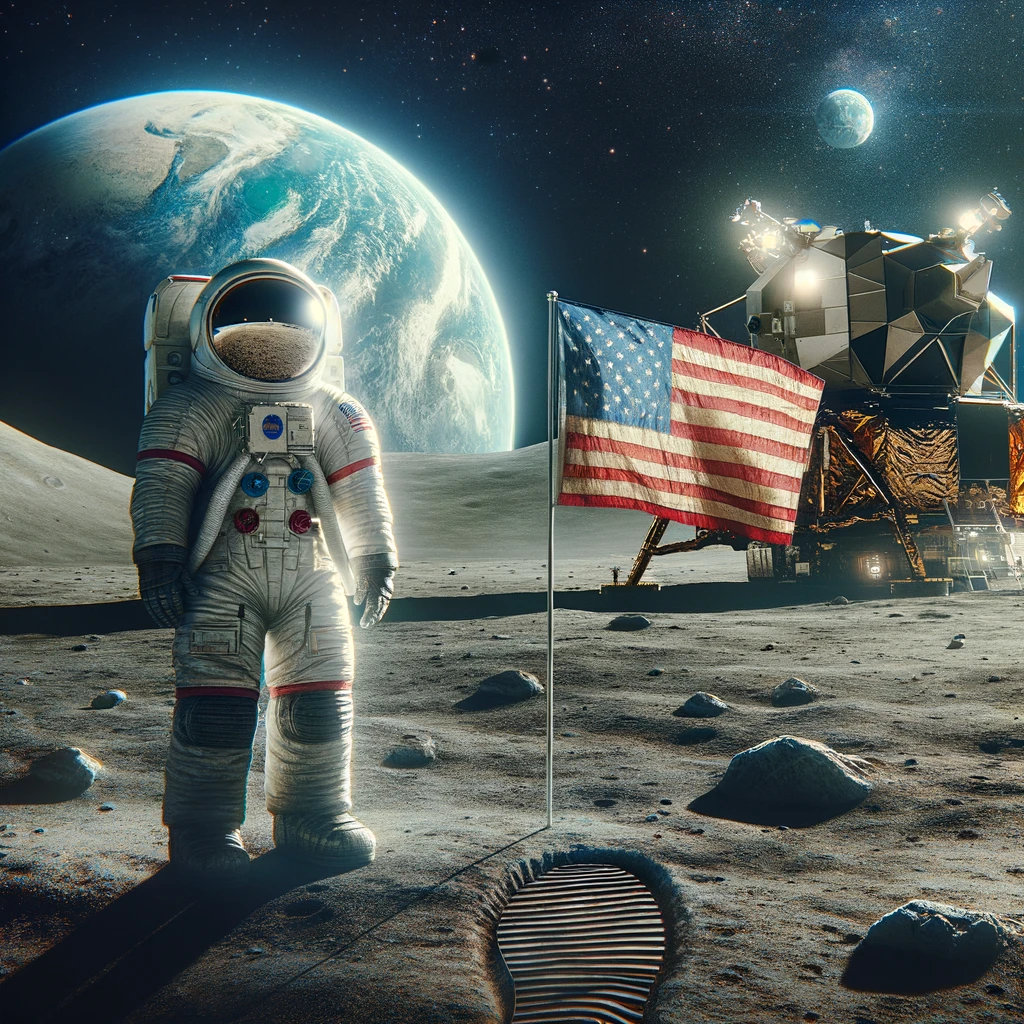After a hiatus of over 50 years, the United States has marked its re-entry onto the lunar surface, signifying a monumental leap in space exploration. This historic moment was made possible by “Odysseus,” a spacecraft launched on February 15 aboard a SpaceX Falcon 9 rocket. Its successful touchdown near the moon’s south pole heralds the dawn of NASA’s ambitious plans for manned missions in the coming years, facilitated by a fleet of uncrewed commercial robots.
The Journey of Odysseus: A New Chapter in Lunar Exploration
Odysseus’s journey was not just a mission but a testament to modern engineering and a shift towards leveraging private industry’s capabilities in space exploration. Despite a suspenseful moment where its operational status was uncertain, the hexagon-shaped vessel achieved a milestone by landing smoothly near the lunar south pole, overcoming the colossal speed of 4,000 miles per hour.
Technological Marvels and Challenges: Innovations and Hurdles in Lunar Landing
Equipped with a novel propulsion system of supercooled liquid oxygen and liquid methane, Odysseus showcased the potential for rapid space travel. However, the mission faced challenges when its navigation system faltered, necessitating a swift software patch to switch to a NASA-developed landing system. This laser pulse technology, crucial for measuring the spacecraft’s velocity and distance from the lunar surface, played a vital role in ensuring a successful landing.
The Significance of the Lunar South Pole: Unlocking the Moon’s Mysteries
The landing site, Malapert A crater, lies tantalizingly close to the lunar south pole, an area of significant interest for future astronaut missions under NASA’s Artemis program. This mission aims to explore the environmental conditions of this largely uncharted territory, gathering crucial data on surface composition, temperature variations, and radiation levels. Such insights are invaluable for planning safe and sustainable human exploration.
Setting the Stage for Manned Missions
Odysseus’s mission serves as a precursor to NASA’s Artemis program, which envisions building a long-term presence on the moon and utilizing lunar resources, such as ice for water and rocket fuel. The successful deployment of Odysseus’s instruments, including cameras and dust particle analyzers, underscores the mission’s role in paving the way for future exploration and habitation.
A New Era of Space Exploration
This mission underscores a strategic shift towards integrating private sector capabilities with national space objectives. Through the Commercial Lunar Payload Services (CLPS) initiative, NASA aims to foster a lunar economy, delegating cargo services to private entities like Intuitive Machines. This collaboration not only propels technological innovation but also opens doors for international contributions to lunar exploration.
The Road Ahead for Lunar Exploration
The successful landing of Odysseus on the moon’s surface after more than half a century is a beacon of progress in space exploration, demonstrating the United States’ renewed commitment to uncovering the moon’s secrets and ensuring humanity’s return to this celestial neighbour. As we stand on the cusp of new discoveries, the collaboration between government agencies and the private sector, coupled with international cooperation, heralds a future where the moon becomes a stepping stone for even more ambitious voyages beyond.
The return of the United States to the moon with the landing of Odysseus near the lunar south pole is not just a milestone in space exploration but a testament to human ingenuity and the spirit of discovery. As Odysseus unveils the mysteries of the lunar south pole, it sets the stage for future missions that will further humanity’s presence in space, promising new horizons for exploration and understanding of our universe.
The Apollo 11 Moon Landing: A Monumental Leap for Mankind
On July 20, 1969, the United States achieved what is arguably humanity’s greatest technological feat: landing the first humans on the Moon. This historic event, part of NASA’s Apollo 11 mission, not only marked the culmination of the intense space race between the United States and the Soviet Union but also opened a new chapter in human exploration and ingenuity. Here’s a look back at the highlights and trivia that have immortalized Apollo 11 in the annals of history.
The Crew That Made History
Apollo 11 was manned by three astronauts: Neil Armstrong, the mission commander and first man to step on the Moon; Edwin “Buzz” Aldrin, the lunar module pilot who followed Armstrong onto the lunar surface; and Michael Collins, the command module pilot who orbited the Moon alone while his colleagues explored the surface.
“That’s One Small Step for [a] Man, One Giant Leap for Mankind”
These immortal words, uttered by Neil Armstrong as he descended onto the Moon’s surface, have become synonymous with human achievement and exploration. Despite the quote’s fame, there’s been debate over whether Armstrong said “a man” or just “man.” Armstrong insisted he intended to say “a man,” though the “a” was lost in transmission back to Earth.
A Watch and a Pen: Unsung Heroes
Among the plethora of high-tech equipment on the mission, two seemingly mundane items played crucial roles. Aldrin used a felt-tip pen to activate a broken circuit breaker, ensuring the astronauts could fire the engine to lift off from the Moon’s surface. Meanwhile, Omega Speedmaster watches, worn by both Armstrong and Aldrin, proved critical for timing the mission’s key events, earning the nickname “Moonwatch.”
Eagle and Columbia: The Craft of Apollo 11
The mission’s spacecraft consisted of two main parts: the command module “Columbia,” which housed the astronauts during their journey to the Moon and back to Earth, and the lunar module “Eagle,” which took Armstrong and Aldrin to the lunar surface. The names of these craft symbolize American freedom and spirit, adding layers of meaning to the mission.
A Global Audience and a Presidential Call
The Moon landing was watched by an estimated 600 million people worldwide, making it one of the most-viewed television broadcasts at the time. Following their successful landing, Armstrong and Aldrin received a phone call from President Richard Nixon, who hailed their mission as “the greatest week in the history of the world since the Creation.”
Moon Souvenirs and the Missing Tapes
The astronauts returned to Earth with 47.5 pounds (21.5 kilograms) of lunar rocks and soil, providing invaluable material for scientific research. Interestingly, the original telemetry tapes of the landing, which contained high-quality video footage, were accidentally erased and reused by NASA in the early 1980s, a loss that remains a poignant footnote in the mission’s legacy.
A Legacy That Endures
The Apollo 11 Moon landing remains a pinnacle of human exploration, symbolizing what humanity can achieve when united by a common goal. It paved the way for subsequent lunar missions and continues to inspire generations to look to the stars and dream of the possibilities that lie beyond our world.
As we reflect on the Apollo 11 mission, it’s clear that this monumental achievement was not just a victory for the United States but a triumph for all of humanity, showcasing our innate desire to explore, understand, and transcend our limits. The legacy of Apollo 11 endures, reminding us of the boundless potential that lies within the human spirit.
Also, read if you’re eligible for the OnePlus12R refund offer
And if you want to learn more about the Farmers’ ‘Delhi Chalo 2.0’ protest




